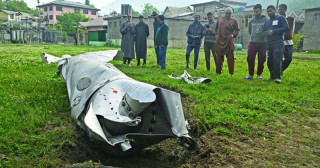Sikandar.dawood
MPA (400+ posts)
The known odds of something or someone living far, far away from Earth improved beyond astronomers boldest dreams on Monday.
Astronomers reported that there could be as many as 40 billion habitable Earth-size planets in the galaxy, based on a new analysis of data fromNASAs Kepler spacecraft.
One out of every five sunlike stars in the galaxy has a planet the size of Earth circling it in the Goldilocks zone not too hot, not too cold where surface temperatures should be compatible with liquid water, according to a herculean three-year calculation based on data from the Kepler spacecraft by Erik Petigura, a graduate student at the University of California, Berkeley.
Mr. Petiguras analysis represents a major step toward the main goal of the Kepler mission, which was to measure what fraction of sunlike stars in the galaxy have Earth-size planets. Sometimes called eta-Earth, it is an important factor in the so-called Drake equation used to estimate the number of intelligent civilizations in the universe. Mr. Petiguras paper, published Monday in the journalProceedings of the National Academy of Sciences, puts another smiley face on a cosmos that has gotten increasingly friendly and fecund-looking over the last 20 years.
It seems that the universe produces plentiful real estate for life that somehow resembles life on Earth, Mr. Petigura said.
Over the last two decades, astronomers have logged more than 1,000 planets around other stars, so-called exoplanets, and Kepler, in its four years of life before being derailed by a mechanical pointing malfunction last winter, has compiled a list of some 3,500 more candidates. The new result could steer plans in the next few years and decades to find a twin of the Earth Earth 2.0, in the argot that is close enough to here to study.
The nearest such planet might be only 12 light-years away. Such a star would be visible to the naked eye, Mr. Petigura said.
His result builds on a report earlier this year by David Charbonneau and Courtney Dressing of the Harvard-Smithsonian Center for Astrophysics, who found that about 15 percent of the smaller and more numerous stars known as red dwarfs have Earth-like planets in their habitable zones. Using slightly less conservative assumptions, Ravi Kopparapu of Pennsylvania State University found that half of all red dwarfs have such planets.
Geoffrey Marcy of the University of California, Berkeley, who supervised Mr. Petiguras research and was a co-author of the paper along with Andrew Howard of the University of Hawaii, said: This is the most important work Ive ever been involved with. This is it. Are there inhabitable Earths out there?
Im feeling a little tingly, he said.
At a news conference Friday discussing the results, astronomers erupted in praise of the Kepler mission and its team. Natalie Batalha, a Kepler leader from the NASA Ames Research Center, described the project and its members as the best of humanity rising to the occasion.
According to Mr. Petiguras new calculation, the fraction of stars with Earth-like planets is 22 percent, plus or minus 8 percent, depending on exactly how you define the habitable zone.
There are several caveats. Although these planets are Earth-size, nobody knows what their masses are and thus whether they are rocky like the Earth, or balls of ice or gas, let alone whether anything can, or does or ever will live on them.
There is reason to believe, from recent observations of other worlds, however, that at least some Earth-size planets, if not all of them, are indeed rocky. Last week, two groups of astronomers announced that an Earth-size planet named Kepler 78b that orbits its sun in 8.5 hours has the same density as the Earth, though it is too hot to support life.
Nature, as Mr. Petigura put it, knows how to make rocky Earth-size planets.
Also, the number is more uncertain than it might have been because Keplers pointing system failed before it could complete its prime survey. As a result, Mr. Petigura and his colleagues had to extrapolate from planets slightly larger than Earth and with slightly smaller, tighter orbits. For the purposes of his analysis Earth-size was anything from one to two times the diameter of the Earth, and Earth-like orbits were between 400 and 200 days.
Dr. Batalha said, We dont yet have any planet candidates that are exact analogues of the Earth in terms of size, orbit or star type.
Though Kepler itself is sidelined while astronomers devise a new program it can accomplish with less flexible pointing ability, it has sent back so much data that there is still a whole years worth of results left to analyze, Dr. Batalha said. Scientists, she said, are going to work on Kepler data for decades. Kepler was launched in 2009 to perform a kind of cosmic census, monitoring the brightness of 150,000 far-off stars in the Cygnus and Lyra constellations, looking for dips in brightness when planets pass in front of them.
Dr. Petigura and his colleagues restricted themselves to a subset of some 42,000 brighter and well-behaved stars. They found 603 planets, of which 10 were between one Earth and two Earths in diameter, and circled in what Mr. Petigura defined as the habitable zone, where they would receive between a quarter of the light the Earth gets, and four times as much. In the solar system, that zone would spread from inside the orbit of Venus to just outside the orbit of Mars.
Meanwhile, in an innovation borrowed from other data-intensive fields like particle physics, Mr. Petigura designed a computer pipeline so that he could inject fake planets into the data 40,000 in all and see how efficiently his program could detect planets of different sizes and orbits. In addition to that correction, he and his colleagues had to correct for geometry; only about one in 100 planet systems is aligned edge-on so that earthlings would see the telltale wink of an exoplanet transit.
It was a ton of work, he recalled, explaining that he had to try out tens of billions of different periods for each star in order to find planets.
Sara Seager, an exoplanet astronomer at the Massachusetts Institute of Technology who was not involved in the work, said the pipeline testing had made the results believable. I would say that small planets are everywhere and very common, she said, no matter how you slice and dice the data. But Kepler is dead and we have no way to get any further data. So well have to be satisfied with this as the final word, for now.
http://www.nytimes.com/2013/11/05/s...-could-be-like-earth.html?pagewanted=all&_r=0
Astronomers reported that there could be as many as 40 billion habitable Earth-size planets in the galaxy, based on a new analysis of data fromNASAs Kepler spacecraft.
One out of every five sunlike stars in the galaxy has a planet the size of Earth circling it in the Goldilocks zone not too hot, not too cold where surface temperatures should be compatible with liquid water, according to a herculean three-year calculation based on data from the Kepler spacecraft by Erik Petigura, a graduate student at the University of California, Berkeley.
Mr. Petiguras analysis represents a major step toward the main goal of the Kepler mission, which was to measure what fraction of sunlike stars in the galaxy have Earth-size planets. Sometimes called eta-Earth, it is an important factor in the so-called Drake equation used to estimate the number of intelligent civilizations in the universe. Mr. Petiguras paper, published Monday in the journalProceedings of the National Academy of Sciences, puts another smiley face on a cosmos that has gotten increasingly friendly and fecund-looking over the last 20 years.
It seems that the universe produces plentiful real estate for life that somehow resembles life on Earth, Mr. Petigura said.
Over the last two decades, astronomers have logged more than 1,000 planets around other stars, so-called exoplanets, and Kepler, in its four years of life before being derailed by a mechanical pointing malfunction last winter, has compiled a list of some 3,500 more candidates. The new result could steer plans in the next few years and decades to find a twin of the Earth Earth 2.0, in the argot that is close enough to here to study.
The nearest such planet might be only 12 light-years away. Such a star would be visible to the naked eye, Mr. Petigura said.
His result builds on a report earlier this year by David Charbonneau and Courtney Dressing of the Harvard-Smithsonian Center for Astrophysics, who found that about 15 percent of the smaller and more numerous stars known as red dwarfs have Earth-like planets in their habitable zones. Using slightly less conservative assumptions, Ravi Kopparapu of Pennsylvania State University found that half of all red dwarfs have such planets.
Geoffrey Marcy of the University of California, Berkeley, who supervised Mr. Petiguras research and was a co-author of the paper along with Andrew Howard of the University of Hawaii, said: This is the most important work Ive ever been involved with. This is it. Are there inhabitable Earths out there?
Im feeling a little tingly, he said.
At a news conference Friday discussing the results, astronomers erupted in praise of the Kepler mission and its team. Natalie Batalha, a Kepler leader from the NASA Ames Research Center, described the project and its members as the best of humanity rising to the occasion.
According to Mr. Petiguras new calculation, the fraction of stars with Earth-like planets is 22 percent, plus or minus 8 percent, depending on exactly how you define the habitable zone.
There are several caveats. Although these planets are Earth-size, nobody knows what their masses are and thus whether they are rocky like the Earth, or balls of ice or gas, let alone whether anything can, or does or ever will live on them.
There is reason to believe, from recent observations of other worlds, however, that at least some Earth-size planets, if not all of them, are indeed rocky. Last week, two groups of astronomers announced that an Earth-size planet named Kepler 78b that orbits its sun in 8.5 hours has the same density as the Earth, though it is too hot to support life.
Nature, as Mr. Petigura put it, knows how to make rocky Earth-size planets.
Also, the number is more uncertain than it might have been because Keplers pointing system failed before it could complete its prime survey. As a result, Mr. Petigura and his colleagues had to extrapolate from planets slightly larger than Earth and with slightly smaller, tighter orbits. For the purposes of his analysis Earth-size was anything from one to two times the diameter of the Earth, and Earth-like orbits were between 400 and 200 days.
Dr. Batalha said, We dont yet have any planet candidates that are exact analogues of the Earth in terms of size, orbit or star type.
Though Kepler itself is sidelined while astronomers devise a new program it can accomplish with less flexible pointing ability, it has sent back so much data that there is still a whole years worth of results left to analyze, Dr. Batalha said. Scientists, she said, are going to work on Kepler data for decades. Kepler was launched in 2009 to perform a kind of cosmic census, monitoring the brightness of 150,000 far-off stars in the Cygnus and Lyra constellations, looking for dips in brightness when planets pass in front of them.
Dr. Petigura and his colleagues restricted themselves to a subset of some 42,000 brighter and well-behaved stars. They found 603 planets, of which 10 were between one Earth and two Earths in diameter, and circled in what Mr. Petigura defined as the habitable zone, where they would receive between a quarter of the light the Earth gets, and four times as much. In the solar system, that zone would spread from inside the orbit of Venus to just outside the orbit of Mars.
Meanwhile, in an innovation borrowed from other data-intensive fields like particle physics, Mr. Petigura designed a computer pipeline so that he could inject fake planets into the data 40,000 in all and see how efficiently his program could detect planets of different sizes and orbits. In addition to that correction, he and his colleagues had to correct for geometry; only about one in 100 planet systems is aligned edge-on so that earthlings would see the telltale wink of an exoplanet transit.
It was a ton of work, he recalled, explaining that he had to try out tens of billions of different periods for each star in order to find planets.
Sara Seager, an exoplanet astronomer at the Massachusetts Institute of Technology who was not involved in the work, said the pipeline testing had made the results believable. I would say that small planets are everywhere and very common, she said, no matter how you slice and dice the data. But Kepler is dead and we have no way to get any further data. So well have to be satisfied with this as the final word, for now.
http://www.nytimes.com/2013/11/05/s...-could-be-like-earth.html?pagewanted=all&_r=0







































